Report on Glencore PLC: Business Environment, Structure and Analysis
VerifiedAdded on 2023/01/17
|13
|3581
|88
Report
AI Summary
This report presents a comprehensive analysis of Glencore PLC's business environment, organizational structure, and the impact of various internal and external factors on its operations. The report begins by defining the business environment and its significance, followed by an overview of different organizational types, including public, private, and voluntary sectors, with examples such as the National Health Service, Marks and Spencer, and Oxfam. It then examines the size and scope of these organizations, highlighting market share, growth, mission, and vision. The report further delves into organizational structures and functions, comparing flat and hierarchical structures and their impact on business operations. The interrelationship between different departments like marketing and finance is also discussed. Finally, the report applies the PESTEL model to analyze the macro environment, focusing on political, economic, social, technological, and environmental factors affecting the UK retail sector and Glencore PLC. The report provides a detailed examination of how these factors influence the business's performance, strengths, and weaknesses.
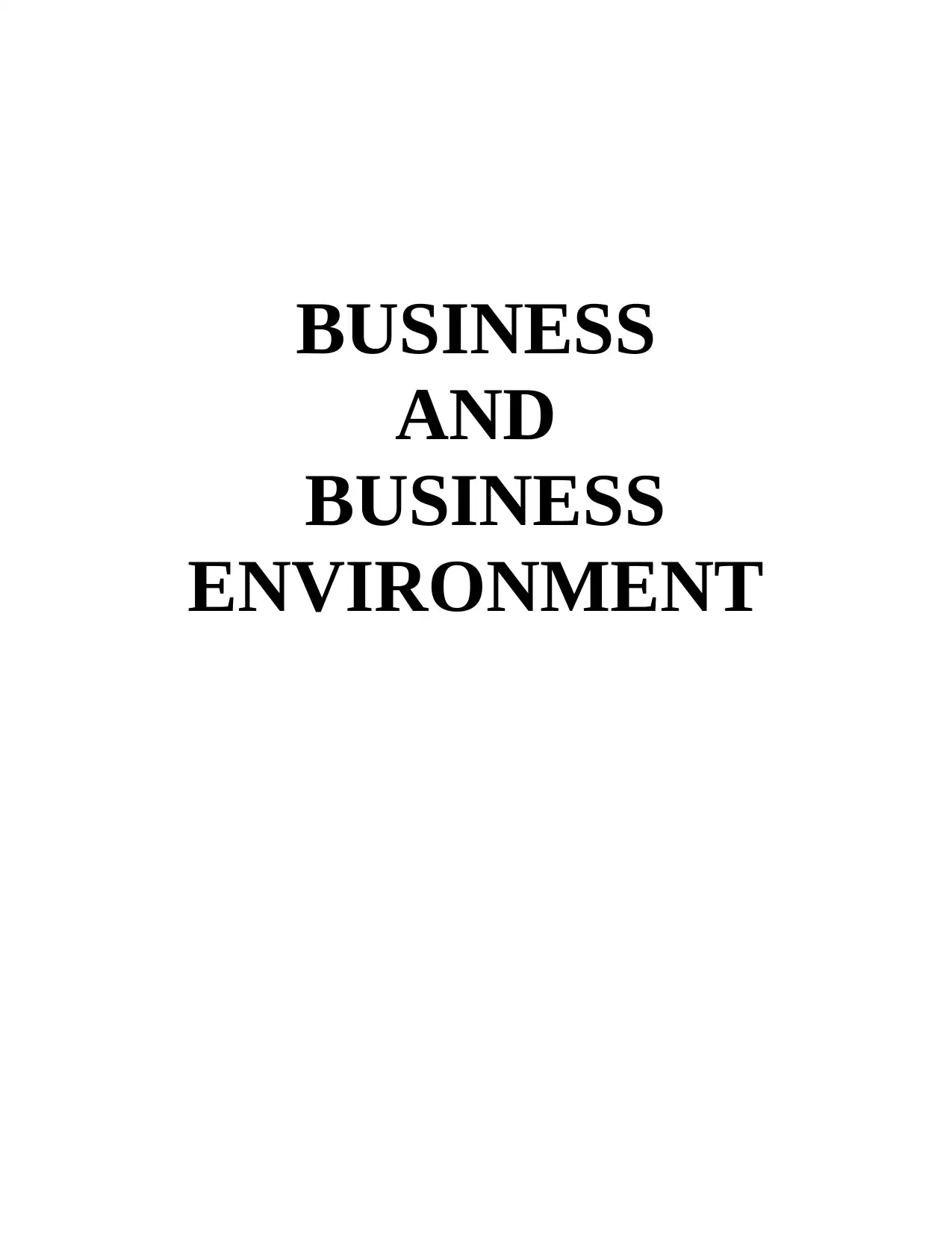
BUSINESS
AND
BUSINESS
ENVIRONMENT
AND
BUSINESS
ENVIRONMENT
Paraphrase This Document
Need a fresh take? Get an instant paraphrase of this document with our AI Paraphraser
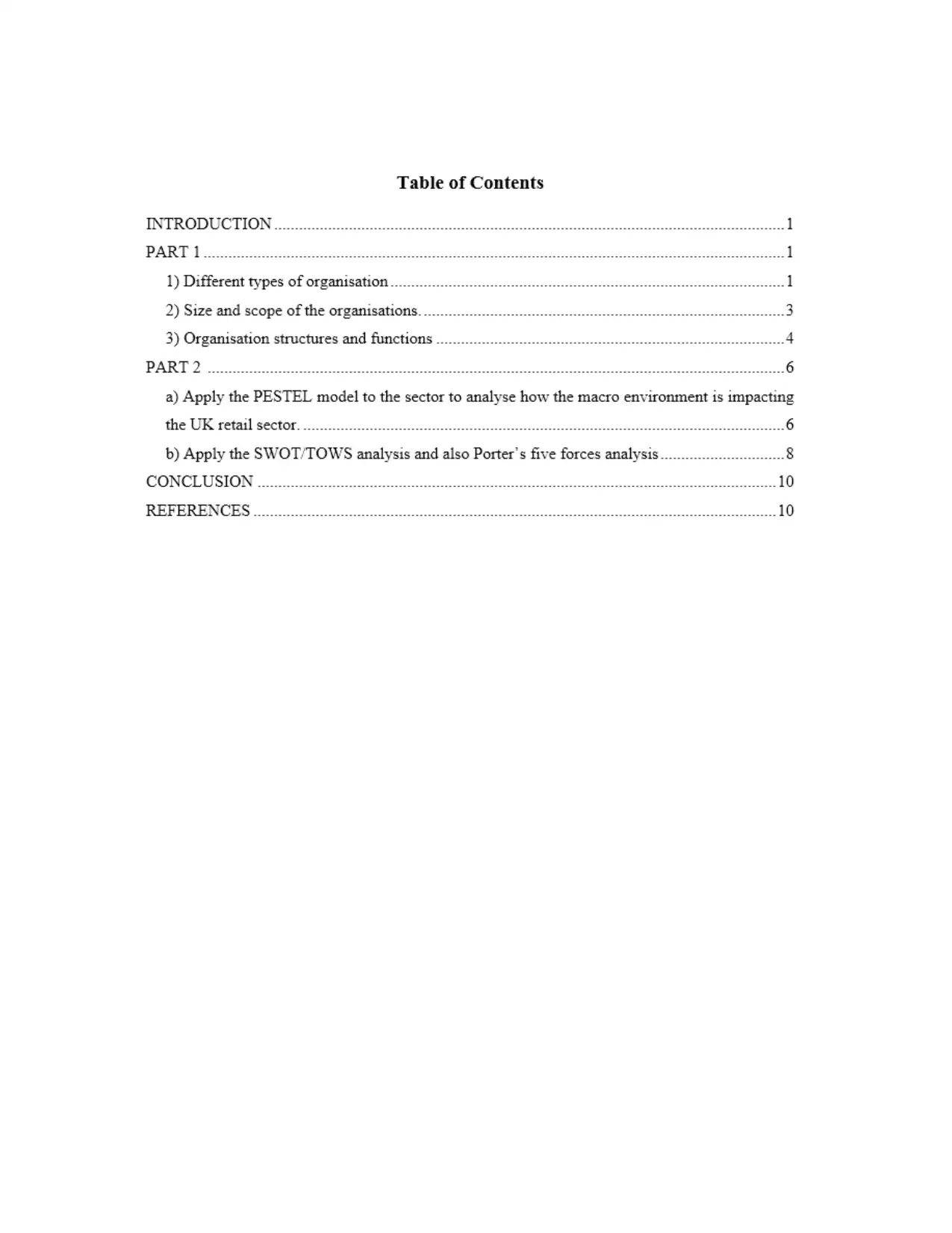
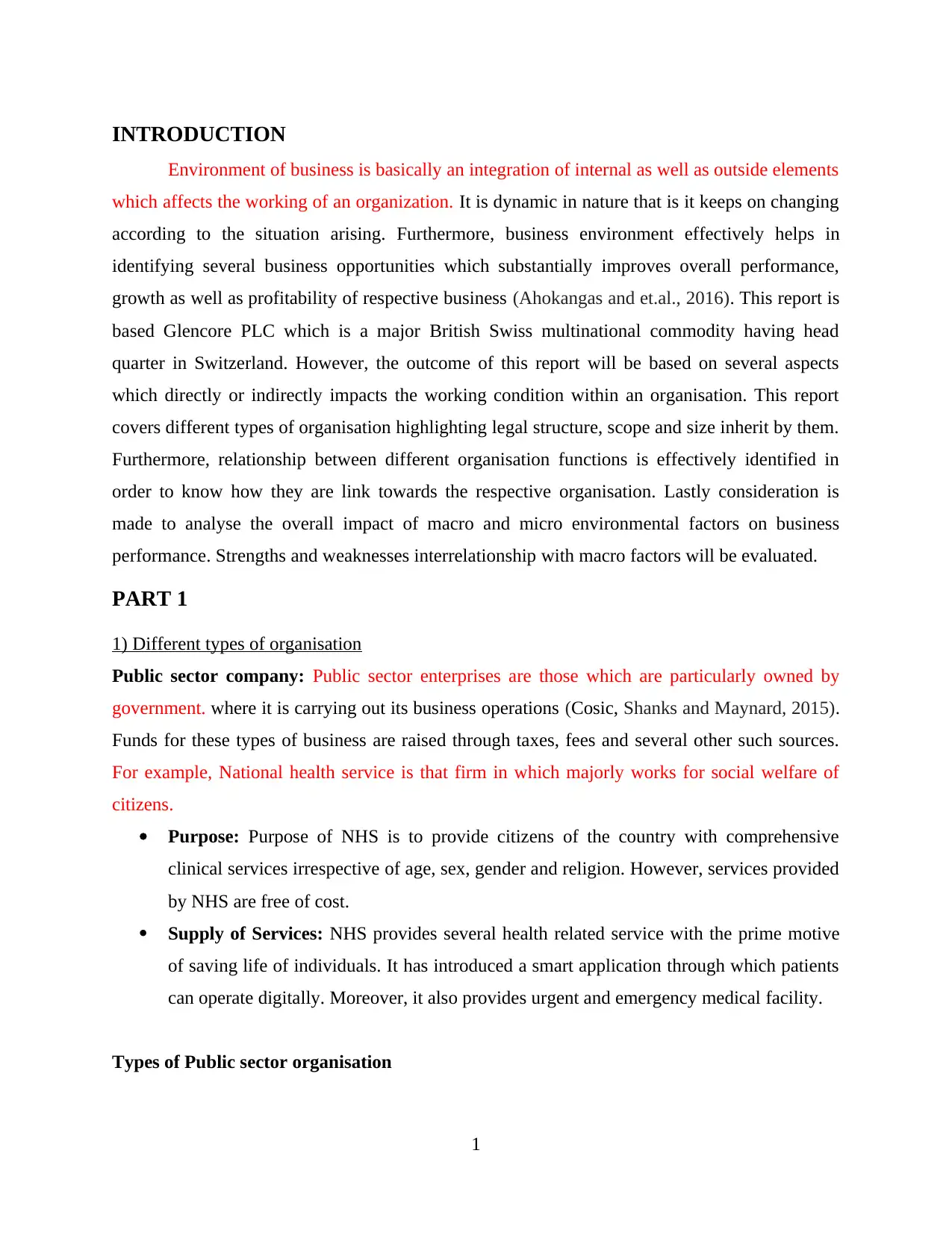
INTRODUCTION
Environment of business is basically an integration of internal as well as outside elements
which affects the working of an organization. It is dynamic in nature that is it keeps on changing
according to the situation arising. Furthermore, business environment effectively helps in
identifying several business opportunities which substantially improves overall performance,
growth as well as profitability of respective business (Ahokangas and et.al., 2016). This report is
based Glencore PLC which is a major British Swiss multinational commodity having head
quarter in Switzerland. However, the outcome of this report will be based on several aspects
which directly or indirectly impacts the working condition within an organisation. This report
covers different types of organisation highlighting legal structure, scope and size inherit by them.
Furthermore, relationship between different organisation functions is effectively identified in
order to know how they are link towards the respective organisation. Lastly consideration is
made to analyse the overall impact of macro and micro environmental factors on business
performance. Strengths and weaknesses interrelationship with macro factors will be evaluated.
PART 1
1) Different types of organisation
Public sector company: Public sector enterprises are those which are particularly owned by
government. where it is carrying out its business operations (Cosic, Shanks and Maynard, 2015).
Funds for these types of business are raised through taxes, fees and several other such sources.
For example, National health service is that firm in which majorly works for social welfare of
citizens.
Purpose: Purpose of NHS is to provide citizens of the country with comprehensive
clinical services irrespective of age, sex, gender and religion. However, services provided
by NHS are free of cost.
Supply of Services: NHS provides several health related service with the prime motive
of saving life of individuals. It has introduced a smart application through which patients
can operate digitally. Moreover, it also provides urgent and emergency medical facility.
Types of Public sector organisation
1
Environment of business is basically an integration of internal as well as outside elements
which affects the working of an organization. It is dynamic in nature that is it keeps on changing
according to the situation arising. Furthermore, business environment effectively helps in
identifying several business opportunities which substantially improves overall performance,
growth as well as profitability of respective business (Ahokangas and et.al., 2016). This report is
based Glencore PLC which is a major British Swiss multinational commodity having head
quarter in Switzerland. However, the outcome of this report will be based on several aspects
which directly or indirectly impacts the working condition within an organisation. This report
covers different types of organisation highlighting legal structure, scope and size inherit by them.
Furthermore, relationship between different organisation functions is effectively identified in
order to know how they are link towards the respective organisation. Lastly consideration is
made to analyse the overall impact of macro and micro environmental factors on business
performance. Strengths and weaknesses interrelationship with macro factors will be evaluated.
PART 1
1) Different types of organisation
Public sector company: Public sector enterprises are those which are particularly owned by
government. where it is carrying out its business operations (Cosic, Shanks and Maynard, 2015).
Funds for these types of business are raised through taxes, fees and several other such sources.
For example, National health service is that firm in which majorly works for social welfare of
citizens.
Purpose: Purpose of NHS is to provide citizens of the country with comprehensive
clinical services irrespective of age, sex, gender and religion. However, services provided
by NHS are free of cost.
Supply of Services: NHS provides several health related service with the prime motive
of saving life of individuals. It has introduced a smart application through which patients
can operate digitally. Moreover, it also provides urgent and emergency medical facility.
Types of Public sector organisation
1
⊘ This is a preview!⊘
Do you want full access?
Subscribe today to unlock all pages.

Trusted by 1+ million students worldwide
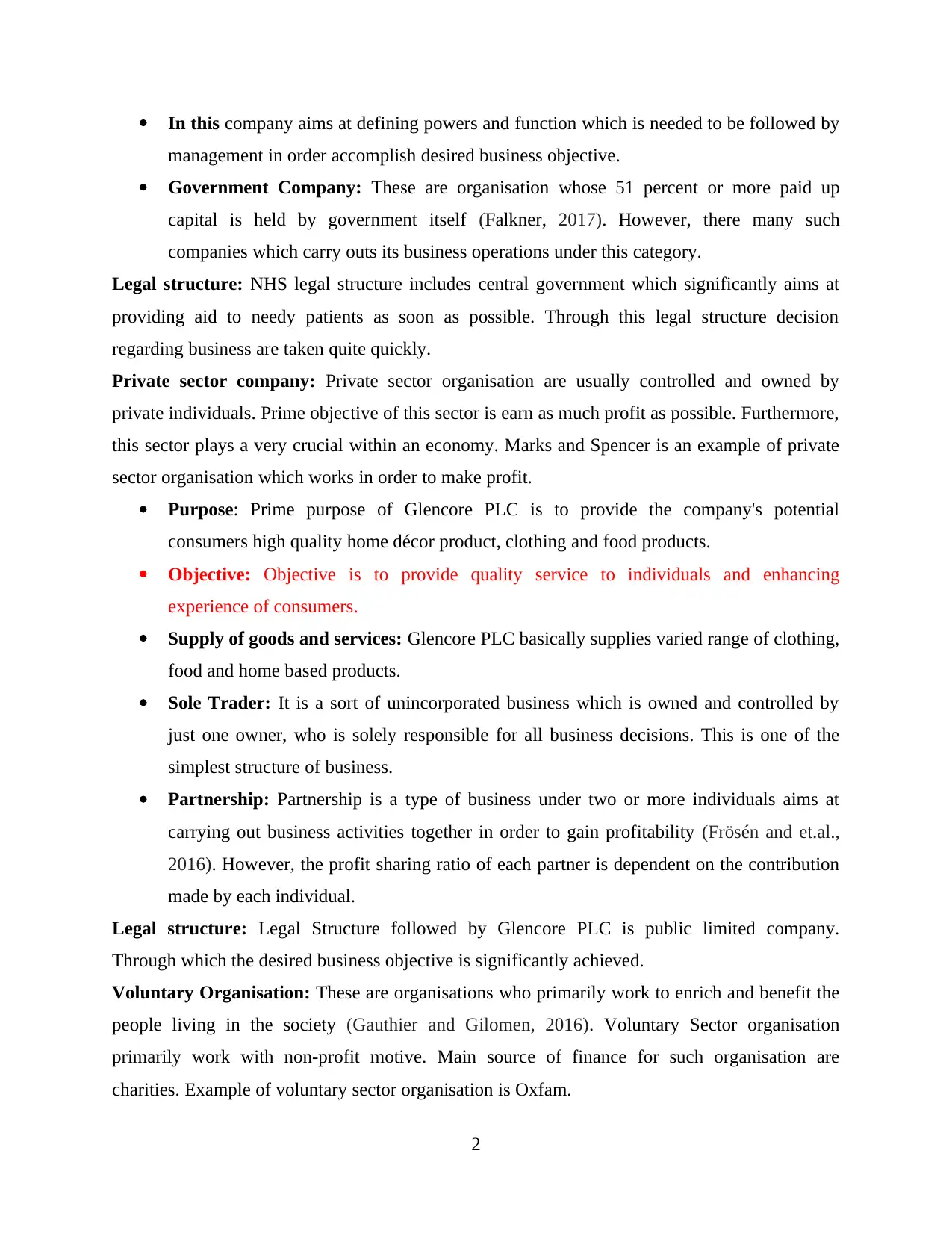
In this company aims at defining powers and function which is needed to be followed by
management in order accomplish desired business objective.
Government Company: These are organisation whose 51 percent or more paid up
capital is held by government itself (Falkner, 2017). However, there many such
companies which carry outs its business operations under this category.
Legal structure: NHS legal structure includes central government which significantly aims at
providing aid to needy patients as soon as possible. Through this legal structure decision
regarding business are taken quite quickly.
Private sector company: Private sector organisation are usually controlled and owned by
private individuals. Prime objective of this sector is earn as much profit as possible. Furthermore,
this sector plays a very crucial within an economy. Marks and Spencer is an example of private
sector organisation which works in order to make profit.
Purpose: Prime purpose of Glencore PLC is to provide the company's potential
consumers high quality home décor product, clothing and food products.
Objective: Objective is to provide quality service to individuals and enhancing
experience of consumers.
Supply of goods and services: Glencore PLC basically supplies varied range of clothing,
food and home based products.
Sole Trader: It is a sort of unincorporated business which is owned and controlled by
just one owner, who is solely responsible for all business decisions. This is one of the
simplest structure of business.
Partnership: Partnership is a type of business under two or more individuals aims at
carrying out business activities together in order to gain profitability (Frösén and et.al.,
2016). However, the profit sharing ratio of each partner is dependent on the contribution
made by each individual.
Legal structure: Legal Structure followed by Glencore PLC is public limited company.
Through which the desired business objective is significantly achieved.
Voluntary Organisation: These are organisations who primarily work to enrich and benefit the
people living in the society (Gauthier and Gilomen, 2016). Voluntary Sector organisation
primarily work with non-profit motive. Main source of finance for such organisation are
charities. Example of voluntary sector organisation is Oxfam.
2
management in order accomplish desired business objective.
Government Company: These are organisation whose 51 percent or more paid up
capital is held by government itself (Falkner, 2017). However, there many such
companies which carry outs its business operations under this category.
Legal structure: NHS legal structure includes central government which significantly aims at
providing aid to needy patients as soon as possible. Through this legal structure decision
regarding business are taken quite quickly.
Private sector company: Private sector organisation are usually controlled and owned by
private individuals. Prime objective of this sector is earn as much profit as possible. Furthermore,
this sector plays a very crucial within an economy. Marks and Spencer is an example of private
sector organisation which works in order to make profit.
Purpose: Prime purpose of Glencore PLC is to provide the company's potential
consumers high quality home décor product, clothing and food products.
Objective: Objective is to provide quality service to individuals and enhancing
experience of consumers.
Supply of goods and services: Glencore PLC basically supplies varied range of clothing,
food and home based products.
Sole Trader: It is a sort of unincorporated business which is owned and controlled by
just one owner, who is solely responsible for all business decisions. This is one of the
simplest structure of business.
Partnership: Partnership is a type of business under two or more individuals aims at
carrying out business activities together in order to gain profitability (Frösén and et.al.,
2016). However, the profit sharing ratio of each partner is dependent on the contribution
made by each individual.
Legal structure: Legal Structure followed by Glencore PLC is public limited company.
Through which the desired business objective is significantly achieved.
Voluntary Organisation: These are organisations who primarily work to enrich and benefit the
people living in the society (Gauthier and Gilomen, 2016). Voluntary Sector organisation
primarily work with non-profit motive. Main source of finance for such organisation are
charities. Example of voluntary sector organisation is Oxfam.
2
Paraphrase This Document
Need a fresh take? Get an instant paraphrase of this document with our AI Paraphraser
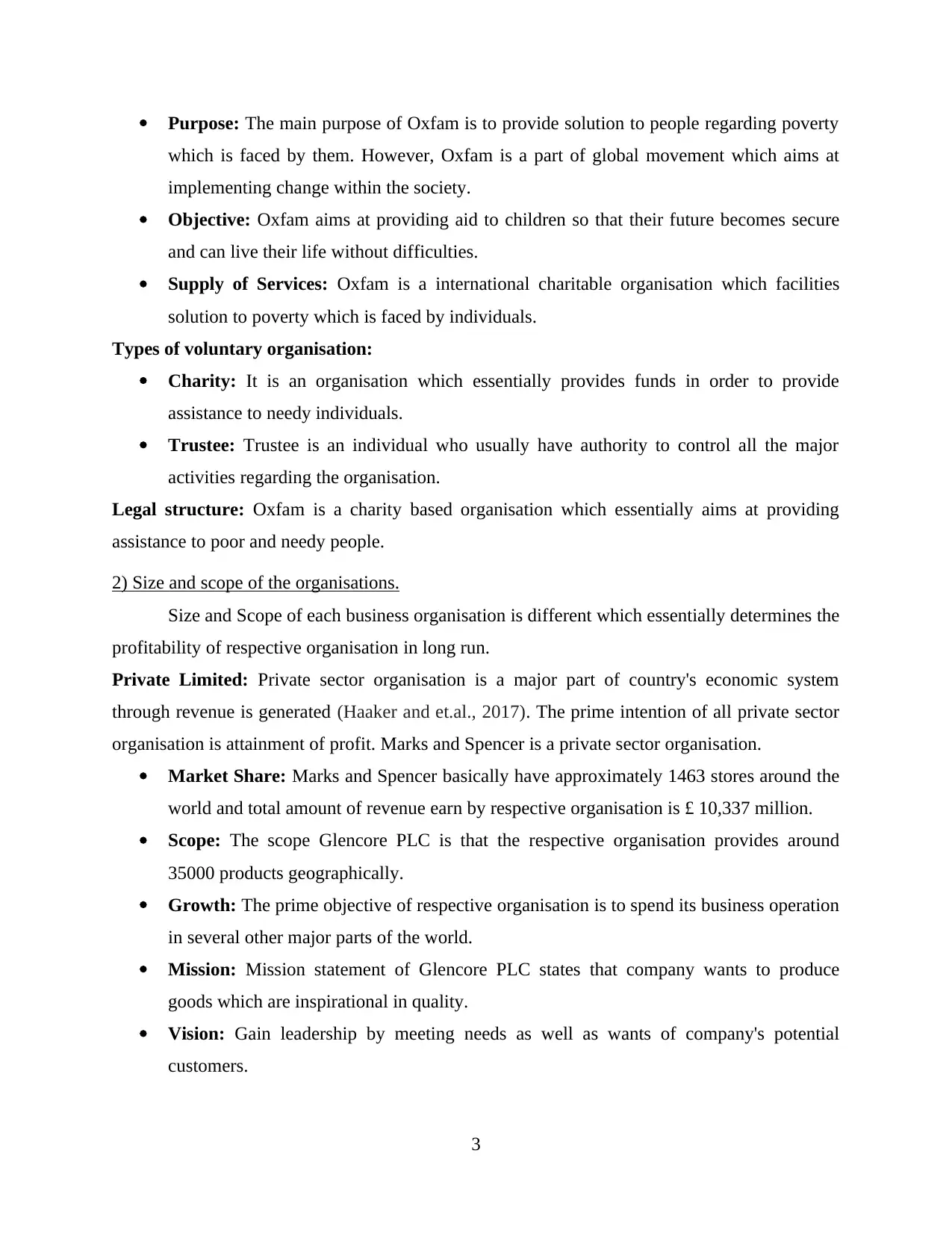
Purpose: The main purpose of Oxfam is to provide solution to people regarding poverty
which is faced by them. However, Oxfam is a part of global movement which aims at
implementing change within the society.
Objective: Oxfam aims at providing aid to children so that their future becomes secure
and can live their life without difficulties.
Supply of Services: Oxfam is a international charitable organisation which facilities
solution to poverty which is faced by individuals.
Types of voluntary organisation:
Charity: It is an organisation which essentially provides funds in order to provide
assistance to needy individuals.
Trustee: Trustee is an individual who usually have authority to control all the major
activities regarding the organisation.
Legal structure: Oxfam is a charity based organisation which essentially aims at providing
assistance to poor and needy people.
2) Size and scope of the organisations.
Size and Scope of each business organisation is different which essentially determines the
profitability of respective organisation in long run.
Private Limited: Private sector organisation is a major part of country's economic system
through revenue is generated (Haaker and et.al., 2017). The prime intention of all private sector
organisation is attainment of profit. Marks and Spencer is a private sector organisation.
Market Share: Marks and Spencer basically have approximately 1463 stores around the
world and total amount of revenue earn by respective organisation is £ 10,337 million.
Scope: The scope Glencore PLC is that the respective organisation provides around
35000 products geographically.
Growth: The prime objective of respective organisation is to spend its business operation
in several other major parts of the world.
Mission: Mission statement of Glencore PLC states that company wants to produce
goods which are inspirational in quality.
Vision: Gain leadership by meeting needs as well as wants of company's potential
customers.
3
which is faced by them. However, Oxfam is a part of global movement which aims at
implementing change within the society.
Objective: Oxfam aims at providing aid to children so that their future becomes secure
and can live their life without difficulties.
Supply of Services: Oxfam is a international charitable organisation which facilities
solution to poverty which is faced by individuals.
Types of voluntary organisation:
Charity: It is an organisation which essentially provides funds in order to provide
assistance to needy individuals.
Trustee: Trustee is an individual who usually have authority to control all the major
activities regarding the organisation.
Legal structure: Oxfam is a charity based organisation which essentially aims at providing
assistance to poor and needy people.
2) Size and scope of the organisations.
Size and Scope of each business organisation is different which essentially determines the
profitability of respective organisation in long run.
Private Limited: Private sector organisation is a major part of country's economic system
through revenue is generated (Haaker and et.al., 2017). The prime intention of all private sector
organisation is attainment of profit. Marks and Spencer is a private sector organisation.
Market Share: Marks and Spencer basically have approximately 1463 stores around the
world and total amount of revenue earn by respective organisation is £ 10,337 million.
Scope: The scope Glencore PLC is that the respective organisation provides around
35000 products geographically.
Growth: The prime objective of respective organisation is to spend its business operation
in several other major parts of the world.
Mission: Mission statement of Glencore PLC states that company wants to produce
goods which are inspirational in quality.
Vision: Gain leadership by meeting needs as well as wants of company's potential
customers.
3
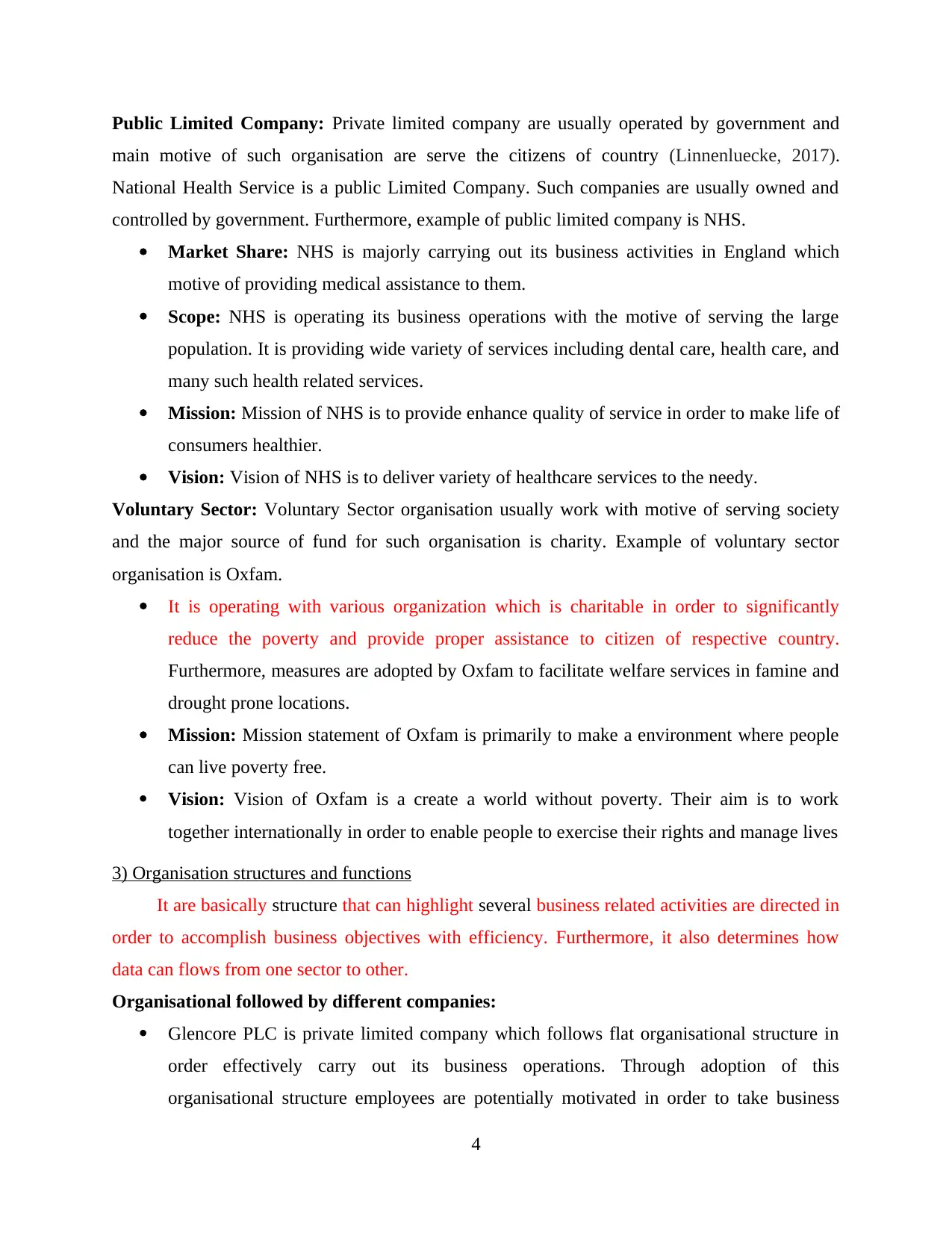
Public Limited Company: Private limited company are usually operated by government and
main motive of such organisation are serve the citizens of country (Linnenluecke, 2017).
National Health Service is a public Limited Company. Such companies are usually owned and
controlled by government. Furthermore, example of public limited company is NHS.
Market Share: NHS is majorly carrying out its business activities in England which
motive of providing medical assistance to them.
Scope: NHS is operating its business operations with the motive of serving the large
population. It is providing wide variety of services including dental care, health care, and
many such health related services.
Mission: Mission of NHS is to provide enhance quality of service in order to make life of
consumers healthier.
Vision: Vision of NHS is to deliver variety of healthcare services to the needy.
Voluntary Sector: Voluntary Sector organisation usually work with motive of serving society
and the major source of fund for such organisation is charity. Example of voluntary sector
organisation is Oxfam.
It is operating with various organization which is charitable in order to significantly
reduce the poverty and provide proper assistance to citizen of respective country.
Furthermore, measures are adopted by Oxfam to facilitate welfare services in famine and
drought prone locations.
Mission: Mission statement of Oxfam is primarily to make a environment where people
can live poverty free.
Vision: Vision of Oxfam is a create a world without poverty. Their aim is to work
together internationally in order to enable people to exercise their rights and manage lives
3) Organisation structures and functions
It are basically structure that can highlight several business related activities are directed in
order to accomplish business objectives with efficiency. Furthermore, it also determines how
data can flows from one sector to other.
Organisational followed by different companies:
Glencore PLC is private limited company which follows flat organisational structure in
order effectively carry out its business operations. Through adoption of this
organisational structure employees are potentially motivated in order to take business
4
main motive of such organisation are serve the citizens of country (Linnenluecke, 2017).
National Health Service is a public Limited Company. Such companies are usually owned and
controlled by government. Furthermore, example of public limited company is NHS.
Market Share: NHS is majorly carrying out its business activities in England which
motive of providing medical assistance to them.
Scope: NHS is operating its business operations with the motive of serving the large
population. It is providing wide variety of services including dental care, health care, and
many such health related services.
Mission: Mission of NHS is to provide enhance quality of service in order to make life of
consumers healthier.
Vision: Vision of NHS is to deliver variety of healthcare services to the needy.
Voluntary Sector: Voluntary Sector organisation usually work with motive of serving society
and the major source of fund for such organisation is charity. Example of voluntary sector
organisation is Oxfam.
It is operating with various organization which is charitable in order to significantly
reduce the poverty and provide proper assistance to citizen of respective country.
Furthermore, measures are adopted by Oxfam to facilitate welfare services in famine and
drought prone locations.
Mission: Mission statement of Oxfam is primarily to make a environment where people
can live poverty free.
Vision: Vision of Oxfam is a create a world without poverty. Their aim is to work
together internationally in order to enable people to exercise their rights and manage lives
3) Organisation structures and functions
It are basically structure that can highlight several business related activities are directed in
order to accomplish business objectives with efficiency. Furthermore, it also determines how
data can flows from one sector to other.
Organisational followed by different companies:
Glencore PLC is private limited company which follows flat organisational structure in
order effectively carry out its business operations. Through adoption of this
organisational structure employees are potentially motivated in order to take business
4
⊘ This is a preview!⊘
Do you want full access?
Subscribe today to unlock all pages.

Trusted by 1+ million students worldwide
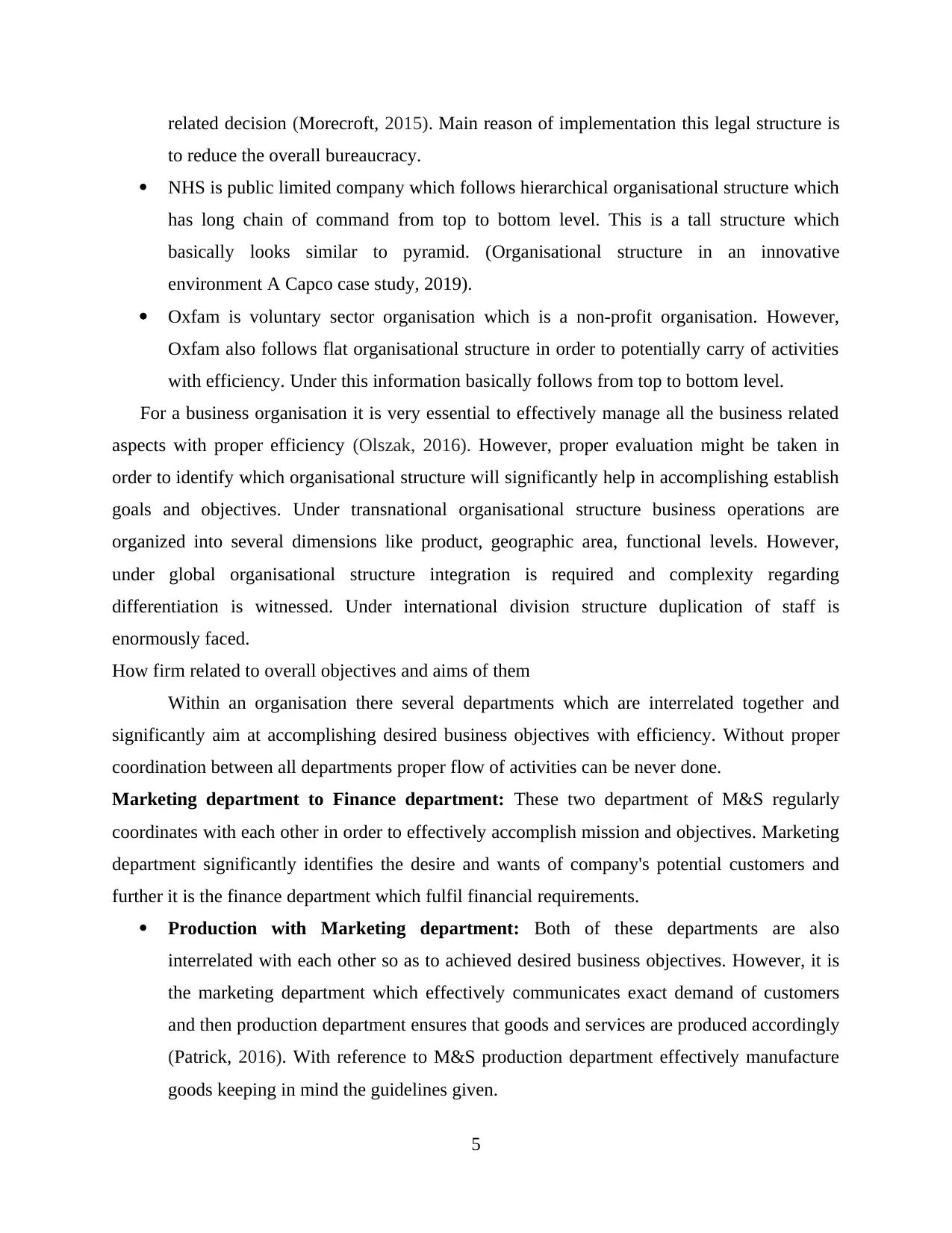
related decision (Morecroft, 2015). Main reason of implementation this legal structure is
to reduce the overall bureaucracy.
NHS is public limited company which follows hierarchical organisational structure which
has long chain of command from top to bottom level. This is a tall structure which
basically looks similar to pyramid. (Organisational structure in an innovative
environment A Capco case study, 2019).
Oxfam is voluntary sector organisation which is a non-profit organisation. However,
Oxfam also follows flat organisational structure in order to potentially carry of activities
with efficiency. Under this information basically follows from top to bottom level.
For a business organisation it is very essential to effectively manage all the business related
aspects with proper efficiency (Olszak, 2016). However, proper evaluation might be taken in
order to identify which organisational structure will significantly help in accomplishing establish
goals and objectives. Under transnational organisational structure business operations are
organized into several dimensions like product, geographic area, functional levels. However,
under global organisational structure integration is required and complexity regarding
differentiation is witnessed. Under international division structure duplication of staff is
enormously faced.
How firm related to overall objectives and aims of them
Within an organisation there several departments which are interrelated together and
significantly aim at accomplishing desired business objectives with efficiency. Without proper
coordination between all departments proper flow of activities can be never done.
Marketing department to Finance department: These two department of M&S regularly
coordinates with each other in order to effectively accomplish mission and objectives. Marketing
department significantly identifies the desire and wants of company's potential customers and
further it is the finance department which fulfil financial requirements.
Production with Marketing department: Both of these departments are also
interrelated with each other so as to achieved desired business objectives. However, it is
the marketing department which effectively communicates exact demand of customers
and then production department ensures that goods and services are produced accordingly
(Patrick, 2016). With reference to M&S production department effectively manufacture
goods keeping in mind the guidelines given.
5
to reduce the overall bureaucracy.
NHS is public limited company which follows hierarchical organisational structure which
has long chain of command from top to bottom level. This is a tall structure which
basically looks similar to pyramid. (Organisational structure in an innovative
environment A Capco case study, 2019).
Oxfam is voluntary sector organisation which is a non-profit organisation. However,
Oxfam also follows flat organisational structure in order to potentially carry of activities
with efficiency. Under this information basically follows from top to bottom level.
For a business organisation it is very essential to effectively manage all the business related
aspects with proper efficiency (Olszak, 2016). However, proper evaluation might be taken in
order to identify which organisational structure will significantly help in accomplishing establish
goals and objectives. Under transnational organisational structure business operations are
organized into several dimensions like product, geographic area, functional levels. However,
under global organisational structure integration is required and complexity regarding
differentiation is witnessed. Under international division structure duplication of staff is
enormously faced.
How firm related to overall objectives and aims of them
Within an organisation there several departments which are interrelated together and
significantly aim at accomplishing desired business objectives with efficiency. Without proper
coordination between all departments proper flow of activities can be never done.
Marketing department to Finance department: These two department of M&S regularly
coordinates with each other in order to effectively accomplish mission and objectives. Marketing
department significantly identifies the desire and wants of company's potential customers and
further it is the finance department which fulfil financial requirements.
Production with Marketing department: Both of these departments are also
interrelated with each other so as to achieved desired business objectives. However, it is
the marketing department which effectively communicates exact demand of customers
and then production department ensures that goods and services are produced accordingly
(Patrick, 2016). With reference to M&S production department effectively manufacture
goods keeping in mind the guidelines given.
5
Paraphrase This Document
Need a fresh take? Get an instant paraphrase of this document with our AI Paraphraser
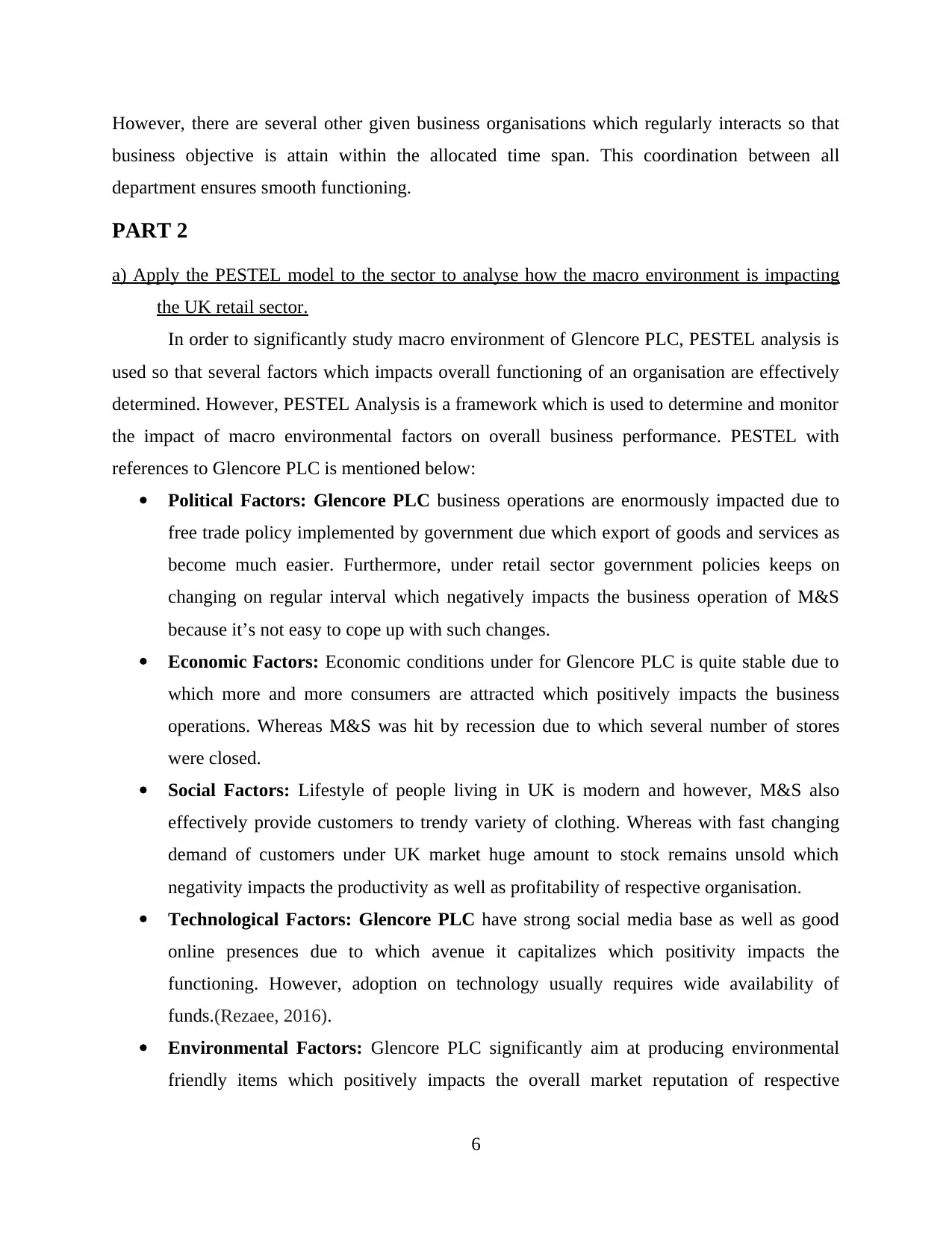
However, there are several other given business organisations which regularly interacts so that
business objective is attain within the allocated time span. This coordination between all
department ensures smooth functioning.
PART 2
a) Apply the PESTEL model to the sector to analyse how the macro environment is impacting
the UK retail sector.
In order to significantly study macro environment of Glencore PLC, PESTEL analysis is
used so that several factors which impacts overall functioning of an organisation are effectively
determined. However, PESTEL Analysis is a framework which is used to determine and monitor
the impact of macro environmental factors on overall business performance. PESTEL with
references to Glencore PLC is mentioned below:
Political Factors: Glencore PLC business operations are enormously impacted due to
free trade policy implemented by government due which export of goods and services as
become much easier. Furthermore, under retail sector government policies keeps on
changing on regular interval which negatively impacts the business operation of M&S
because it’s not easy to cope up with such changes.
Economic Factors: Economic conditions under for Glencore PLC is quite stable due to
which more and more consumers are attracted which positively impacts the business
operations. Whereas M&S was hit by recession due to which several number of stores
were closed.
Social Factors: Lifestyle of people living in UK is modern and however, M&S also
effectively provide customers to trendy variety of clothing. Whereas with fast changing
demand of customers under UK market huge amount to stock remains unsold which
negativity impacts the productivity as well as profitability of respective organisation.
Technological Factors: Glencore PLC have strong social media base as well as good
online presences due to which avenue it capitalizes which positivity impacts the
functioning. However, adoption on technology usually requires wide availability of
funds.(Rezaee, 2016).
Environmental Factors: Glencore PLC significantly aim at producing environmental
friendly items which positively impacts the overall market reputation of respective
6
business objective is attain within the allocated time span. This coordination between all
department ensures smooth functioning.
PART 2
a) Apply the PESTEL model to the sector to analyse how the macro environment is impacting
the UK retail sector.
In order to significantly study macro environment of Glencore PLC, PESTEL analysis is
used so that several factors which impacts overall functioning of an organisation are effectively
determined. However, PESTEL Analysis is a framework which is used to determine and monitor
the impact of macro environmental factors on overall business performance. PESTEL with
references to Glencore PLC is mentioned below:
Political Factors: Glencore PLC business operations are enormously impacted due to
free trade policy implemented by government due which export of goods and services as
become much easier. Furthermore, under retail sector government policies keeps on
changing on regular interval which negatively impacts the business operation of M&S
because it’s not easy to cope up with such changes.
Economic Factors: Economic conditions under for Glencore PLC is quite stable due to
which more and more consumers are attracted which positively impacts the business
operations. Whereas M&S was hit by recession due to which several number of stores
were closed.
Social Factors: Lifestyle of people living in UK is modern and however, M&S also
effectively provide customers to trendy variety of clothing. Whereas with fast changing
demand of customers under UK market huge amount to stock remains unsold which
negativity impacts the productivity as well as profitability of respective organisation.
Technological Factors: Glencore PLC have strong social media base as well as good
online presences due to which avenue it capitalizes which positivity impacts the
functioning. However, adoption on technology usually requires wide availability of
funds.(Rezaee, 2016).
Environmental Factors: Glencore PLC significantly aim at producing environmental
friendly items which positively impacts the overall market reputation of respective
6
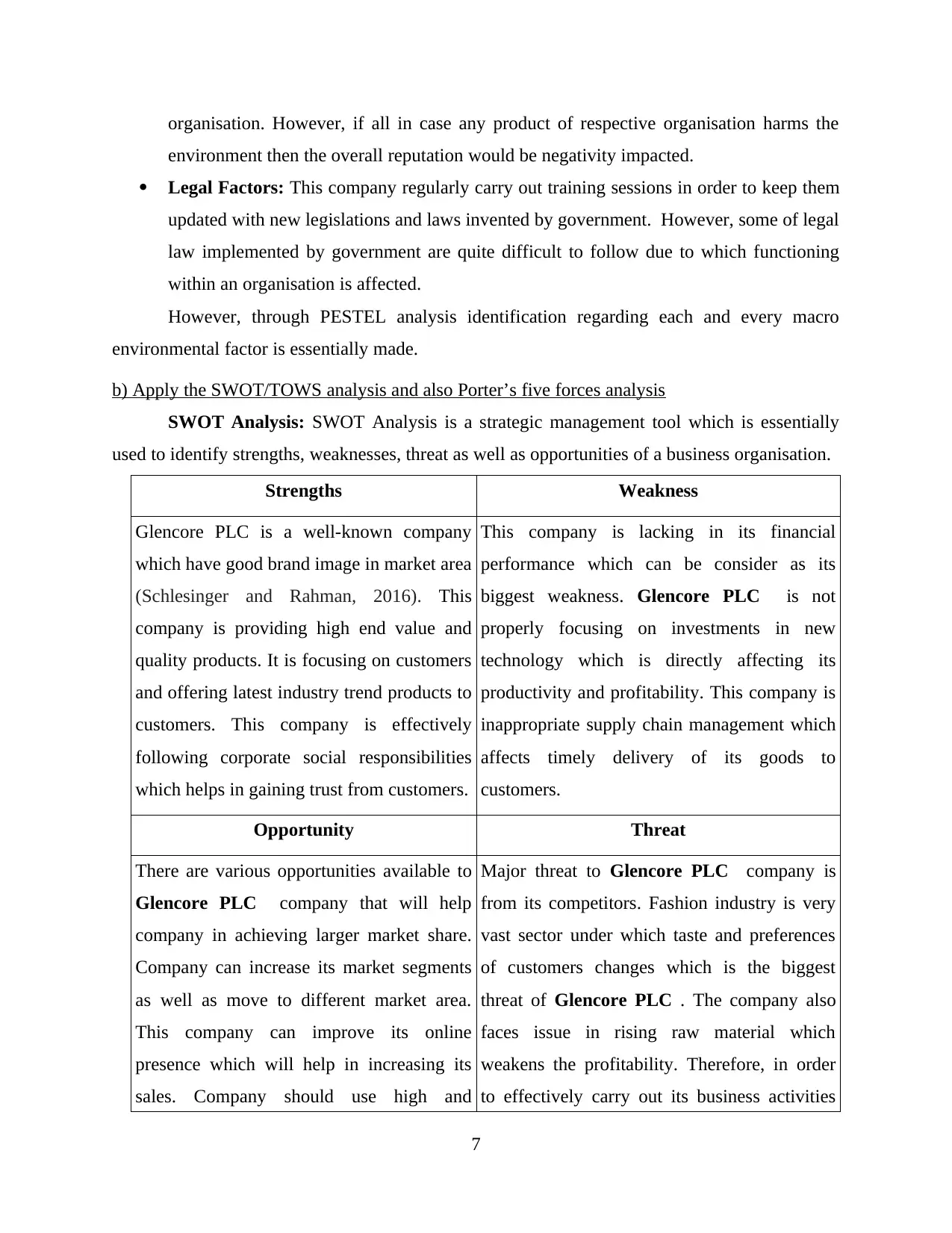
organisation. However, if all in case any product of respective organisation harms the
environment then the overall reputation would be negativity impacted.
Legal Factors: This company regularly carry out training sessions in order to keep them
updated with new legislations and laws invented by government. However, some of legal
law implemented by government are quite difficult to follow due to which functioning
within an organisation is affected.
However, through PESTEL analysis identification regarding each and every macro
environmental factor is essentially made.
b) Apply the SWOT/TOWS analysis and also Porter’s five forces analysis
SWOT Analysis: SWOT Analysis is a strategic management tool which is essentially
used to identify strengths, weaknesses, threat as well as opportunities of a business organisation.
Strengths Weakness
Glencore PLC is a well-known company
which have good brand image in market area
(Schlesinger and Rahman, 2016). This
company is providing high end value and
quality products. It is focusing on customers
and offering latest industry trend products to
customers. This company is effectively
following corporate social responsibilities
which helps in gaining trust from customers.
This company is lacking in its financial
performance which can be consider as its
biggest weakness. Glencore PLC is not
properly focusing on investments in new
technology which is directly affecting its
productivity and profitability. This company is
inappropriate supply chain management which
affects timely delivery of its goods to
customers.
Opportunity Threat
There are various opportunities available to
Glencore PLC company that will help
company in achieving larger market share.
Company can increase its market segments
as well as move to different market area.
This company can improve its online
presence which will help in increasing its
sales. Company should use high and
Major threat to Glencore PLC company is
from its competitors. Fashion industry is very
vast sector under which taste and preferences
of customers changes which is the biggest
threat of Glencore PLC . The company also
faces issue in rising raw material which
weakens the profitability. Therefore, in order
to effectively carry out its business activities
7
environment then the overall reputation would be negativity impacted.
Legal Factors: This company regularly carry out training sessions in order to keep them
updated with new legislations and laws invented by government. However, some of legal
law implemented by government are quite difficult to follow due to which functioning
within an organisation is affected.
However, through PESTEL analysis identification regarding each and every macro
environmental factor is essentially made.
b) Apply the SWOT/TOWS analysis and also Porter’s five forces analysis
SWOT Analysis: SWOT Analysis is a strategic management tool which is essentially
used to identify strengths, weaknesses, threat as well as opportunities of a business organisation.
Strengths Weakness
Glencore PLC is a well-known company
which have good brand image in market area
(Schlesinger and Rahman, 2016). This
company is providing high end value and
quality products. It is focusing on customers
and offering latest industry trend products to
customers. This company is effectively
following corporate social responsibilities
which helps in gaining trust from customers.
This company is lacking in its financial
performance which can be consider as its
biggest weakness. Glencore PLC is not
properly focusing on investments in new
technology which is directly affecting its
productivity and profitability. This company is
inappropriate supply chain management which
affects timely delivery of its goods to
customers.
Opportunity Threat
There are various opportunities available to
Glencore PLC company that will help
company in achieving larger market share.
Company can increase its market segments
as well as move to different market area.
This company can improve its online
presence which will help in increasing its
sales. Company should use high and
Major threat to Glencore PLC company is
from its competitors. Fashion industry is very
vast sector under which taste and preferences
of customers changes which is the biggest
threat of Glencore PLC . The company also
faces issue in rising raw material which
weakens the profitability. Therefore, in order
to effectively carry out its business activities
7
⊘ This is a preview!⊘
Do you want full access?
Subscribe today to unlock all pages.

Trusted by 1+ million students worldwide
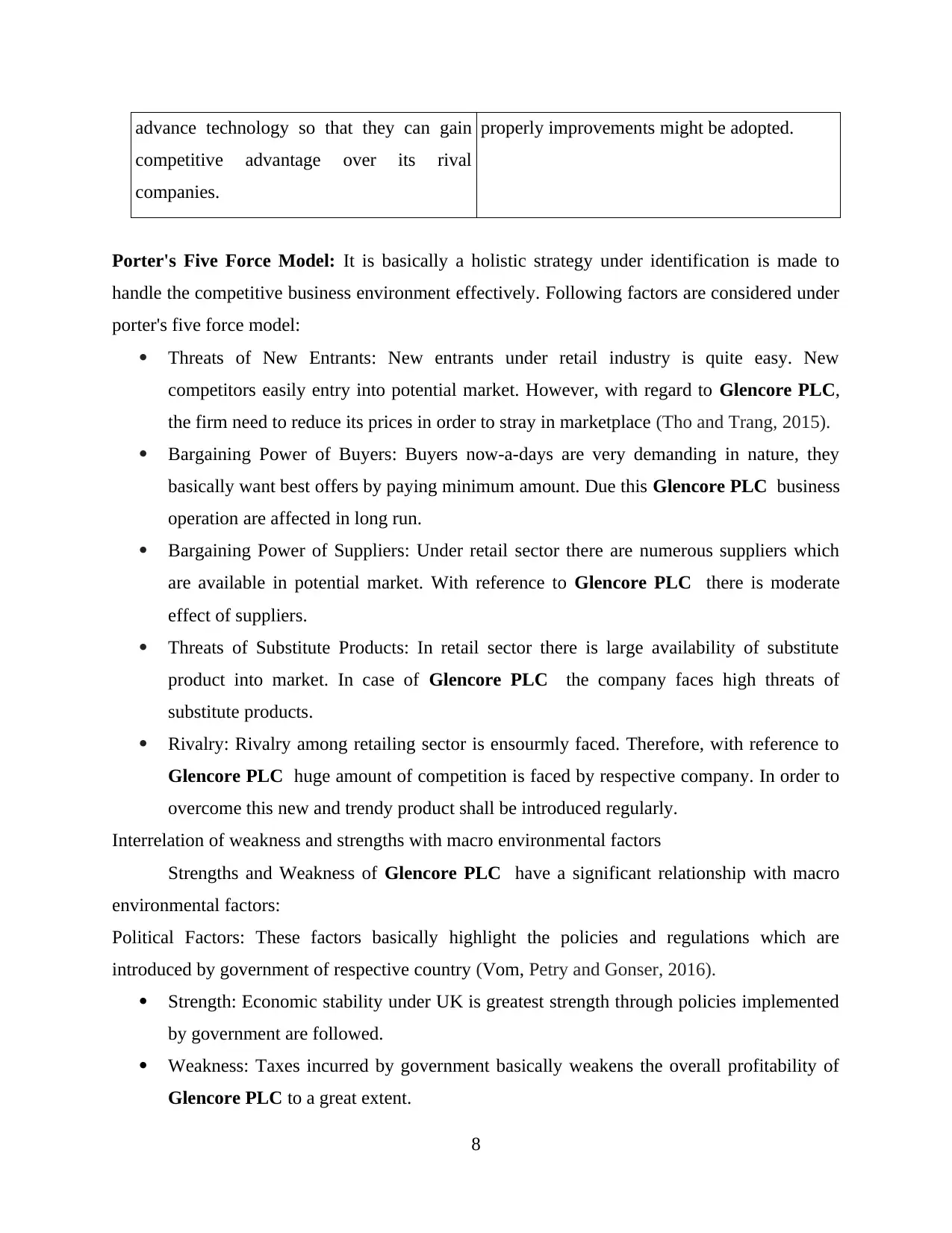
advance technology so that they can gain
competitive advantage over its rival
companies.
properly improvements might be adopted.
Porter's Five Force Model: It is basically a holistic strategy under identification is made to
handle the competitive business environment effectively. Following factors are considered under
porter's five force model:
Threats of New Entrants: New entrants under retail industry is quite easy. New
competitors easily entry into potential market. However, with regard to Glencore PLC,
the firm need to reduce its prices in order to stray in marketplace (Tho and Trang, 2015).
Bargaining Power of Buyers: Buyers now-a-days are very demanding in nature, they
basically want best offers by paying minimum amount. Due this Glencore PLC business
operation are affected in long run.
Bargaining Power of Suppliers: Under retail sector there are numerous suppliers which
are available in potential market. With reference to Glencore PLC there is moderate
effect of suppliers.
Threats of Substitute Products: In retail sector there is large availability of substitute
product into market. In case of Glencore PLC the company faces high threats of
substitute products.
Rivalry: Rivalry among retailing sector is ensourmly faced. Therefore, with reference to
Glencore PLC huge amount of competition is faced by respective company. In order to
overcome this new and trendy product shall be introduced regularly.
Interrelation of weakness and strengths with macro environmental factors
Strengths and Weakness of Glencore PLC have a significant relationship with macro
environmental factors:
Political Factors: These factors basically highlight the policies and regulations which are
introduced by government of respective country (Vom, Petry and Gonser, 2016).
Strength: Economic stability under UK is greatest strength through policies implemented
by government are followed.
Weakness: Taxes incurred by government basically weakens the overall profitability of
Glencore PLC to a great extent.
8
competitive advantage over its rival
companies.
properly improvements might be adopted.
Porter's Five Force Model: It is basically a holistic strategy under identification is made to
handle the competitive business environment effectively. Following factors are considered under
porter's five force model:
Threats of New Entrants: New entrants under retail industry is quite easy. New
competitors easily entry into potential market. However, with regard to Glencore PLC,
the firm need to reduce its prices in order to stray in marketplace (Tho and Trang, 2015).
Bargaining Power of Buyers: Buyers now-a-days are very demanding in nature, they
basically want best offers by paying minimum amount. Due this Glencore PLC business
operation are affected in long run.
Bargaining Power of Suppliers: Under retail sector there are numerous suppliers which
are available in potential market. With reference to Glencore PLC there is moderate
effect of suppliers.
Threats of Substitute Products: In retail sector there is large availability of substitute
product into market. In case of Glencore PLC the company faces high threats of
substitute products.
Rivalry: Rivalry among retailing sector is ensourmly faced. Therefore, with reference to
Glencore PLC huge amount of competition is faced by respective company. In order to
overcome this new and trendy product shall be introduced regularly.
Interrelation of weakness and strengths with macro environmental factors
Strengths and Weakness of Glencore PLC have a significant relationship with macro
environmental factors:
Political Factors: These factors basically highlight the policies and regulations which are
introduced by government of respective country (Vom, Petry and Gonser, 2016).
Strength: Economic stability under UK is greatest strength through policies implemented
by government are followed.
Weakness: Taxes incurred by government basically weakens the overall profitability of
Glencore PLC to a great extent.
8
Paraphrase This Document
Need a fresh take? Get an instant paraphrase of this document with our AI Paraphraser
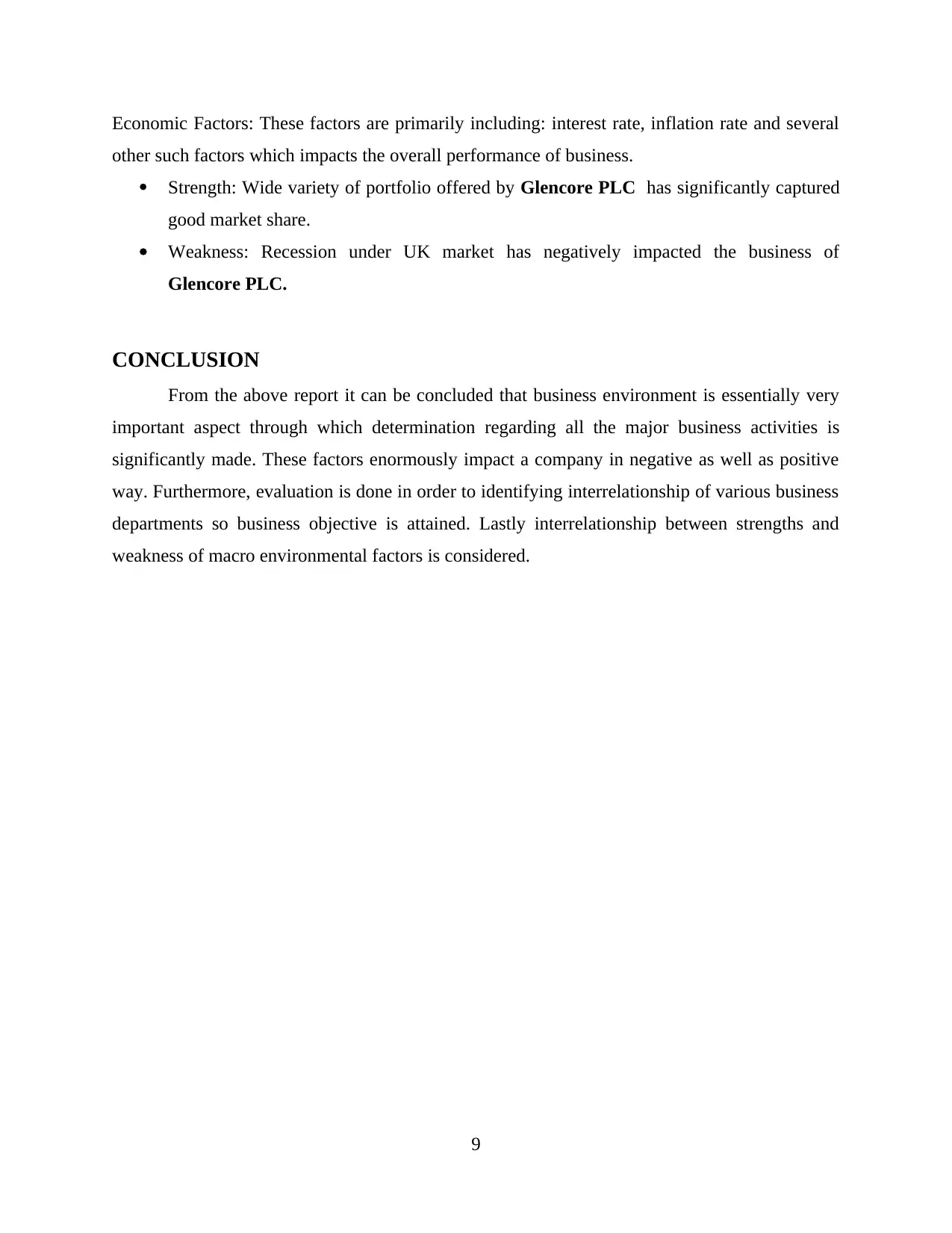
Economic Factors: These factors are primarily including: interest rate, inflation rate and several
other such factors which impacts the overall performance of business.
Strength: Wide variety of portfolio offered by Glencore PLC has significantly captured
good market share.
Weakness: Recession under UK market has negatively impacted the business of
Glencore PLC.
CONCLUSION
From the above report it can be concluded that business environment is essentially very
important aspect through which determination regarding all the major business activities is
significantly made. These factors enormously impact a company in negative as well as positive
way. Furthermore, evaluation is done in order to identifying interrelationship of various business
departments so business objective is attained. Lastly interrelationship between strengths and
weakness of macro environmental factors is considered.
9
other such factors which impacts the overall performance of business.
Strength: Wide variety of portfolio offered by Glencore PLC has significantly captured
good market share.
Weakness: Recession under UK market has negatively impacted the business of
Glencore PLC.
CONCLUSION
From the above report it can be concluded that business environment is essentially very
important aspect through which determination regarding all the major business activities is
significantly made. These factors enormously impact a company in negative as well as positive
way. Furthermore, evaluation is done in order to identifying interrelationship of various business
departments so business objective is attained. Lastly interrelationship between strengths and
weakness of macro environmental factors is considered.
9
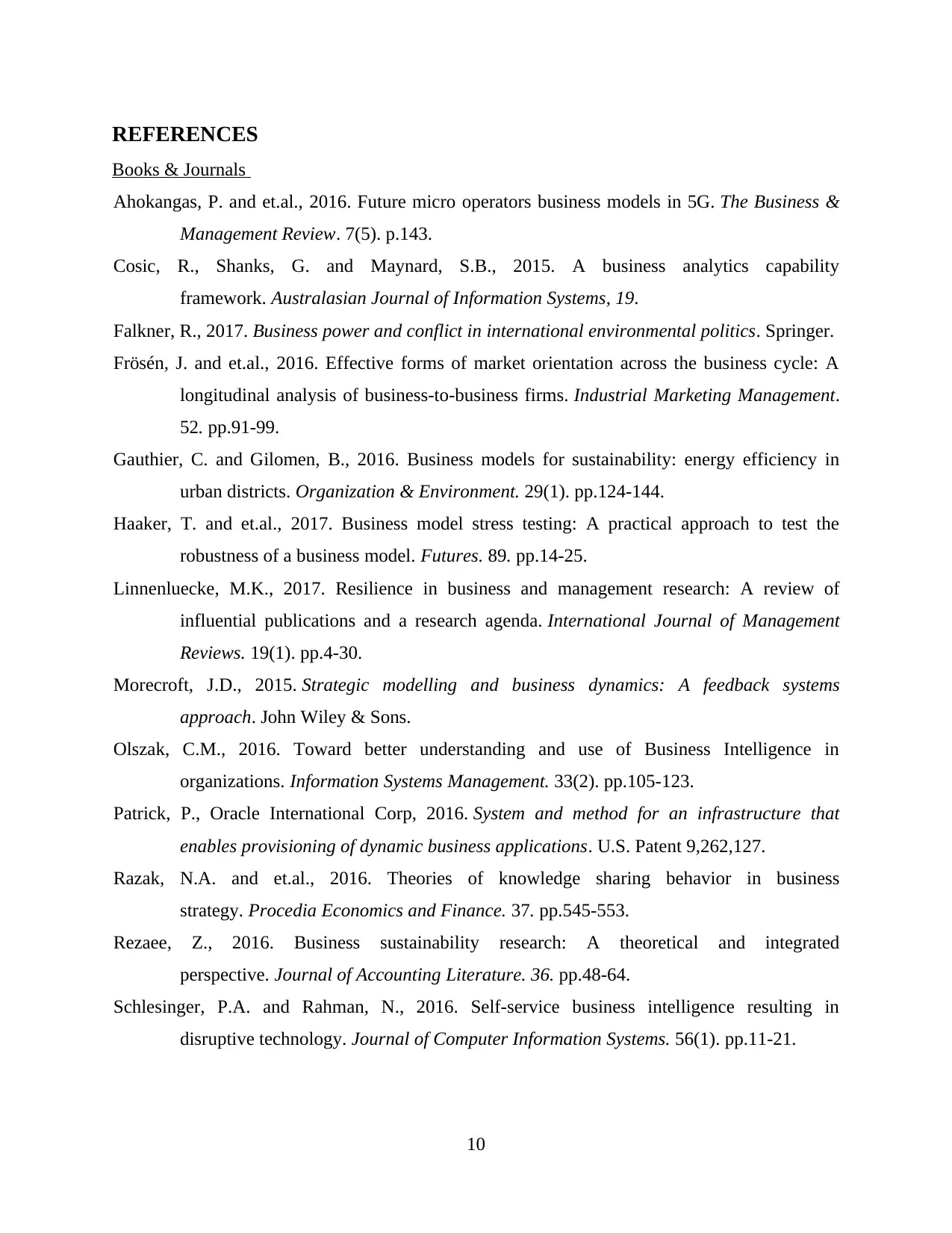
REFERENCES
Books & Journals
Ahokangas, P. and et.al., 2016. Future micro operators business models in 5G. The Business &
Management Review. 7(5). p.143.
Cosic, R., Shanks, G. and Maynard, S.B., 2015. A business analytics capability
framework. Australasian Journal of Information Systems, 19.
Falkner, R., 2017. Business power and conflict in international environmental politics. Springer.
Frösén, J. and et.al., 2016. Effective forms of market orientation across the business cycle: A
longitudinal analysis of business-to-business firms. Industrial Marketing Management.
52. pp.91-99.
Gauthier, C. and Gilomen, B., 2016. Business models for sustainability: energy efficiency in
urban districts. Organization & Environment. 29(1). pp.124-144.
Haaker, T. and et.al., 2017. Business model stress testing: A practical approach to test the
robustness of a business model. Futures. 89. pp.14-25.
Linnenluecke, M.K., 2017. Resilience in business and management research: A review of
influential publications and a research agenda. International Journal of Management
Reviews. 19(1). pp.4-30.
Morecroft, J.D., 2015. Strategic modelling and business dynamics: A feedback systems
approach. John Wiley & Sons.
Olszak, C.M., 2016. Toward better understanding and use of Business Intelligence in
organizations. Information Systems Management. 33(2). pp.105-123.
Patrick, P., Oracle International Corp, 2016. System and method for an infrastructure that
enables provisioning of dynamic business applications. U.S. Patent 9,262,127.
Razak, N.A. and et.al., 2016. Theories of knowledge sharing behavior in business
strategy. Procedia Economics and Finance. 37. pp.545-553.
Rezaee, Z., 2016. Business sustainability research: A theoretical and integrated
perspective. Journal of Accounting Literature. 36. pp.48-64.
Schlesinger, P.A. and Rahman, N., 2016. Self-service business intelligence resulting in
disruptive technology. Journal of Computer Information Systems. 56(1). pp.11-21.
10
Books & Journals
Ahokangas, P. and et.al., 2016. Future micro operators business models in 5G. The Business &
Management Review. 7(5). p.143.
Cosic, R., Shanks, G. and Maynard, S.B., 2015. A business analytics capability
framework. Australasian Journal of Information Systems, 19.
Falkner, R., 2017. Business power and conflict in international environmental politics. Springer.
Frösén, J. and et.al., 2016. Effective forms of market orientation across the business cycle: A
longitudinal analysis of business-to-business firms. Industrial Marketing Management.
52. pp.91-99.
Gauthier, C. and Gilomen, B., 2016. Business models for sustainability: energy efficiency in
urban districts. Organization & Environment. 29(1). pp.124-144.
Haaker, T. and et.al., 2017. Business model stress testing: A practical approach to test the
robustness of a business model. Futures. 89. pp.14-25.
Linnenluecke, M.K., 2017. Resilience in business and management research: A review of
influential publications and a research agenda. International Journal of Management
Reviews. 19(1). pp.4-30.
Morecroft, J.D., 2015. Strategic modelling and business dynamics: A feedback systems
approach. John Wiley & Sons.
Olszak, C.M., 2016. Toward better understanding and use of Business Intelligence in
organizations. Information Systems Management. 33(2). pp.105-123.
Patrick, P., Oracle International Corp, 2016. System and method for an infrastructure that
enables provisioning of dynamic business applications. U.S. Patent 9,262,127.
Razak, N.A. and et.al., 2016. Theories of knowledge sharing behavior in business
strategy. Procedia Economics and Finance. 37. pp.545-553.
Rezaee, Z., 2016. Business sustainability research: A theoretical and integrated
perspective. Journal of Accounting Literature. 36. pp.48-64.
Schlesinger, P.A. and Rahman, N., 2016. Self-service business intelligence resulting in
disruptive technology. Journal of Computer Information Systems. 56(1). pp.11-21.
10
⊘ This is a preview!⊘
Do you want full access?
Subscribe today to unlock all pages.

Trusted by 1+ million students worldwide
1 out of 13
Related Documents
Your All-in-One AI-Powered Toolkit for Academic Success.
+13062052269
info@desklib.com
Available 24*7 on WhatsApp / Email
![[object Object]](/_next/static/media/star-bottom.7253800d.svg)
Unlock your academic potential
Copyright © 2020–2025 A2Z Services. All Rights Reserved. Developed and managed by ZUCOL.





